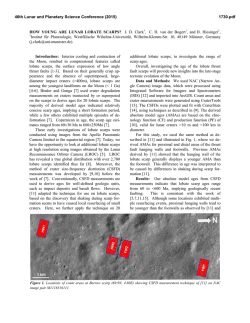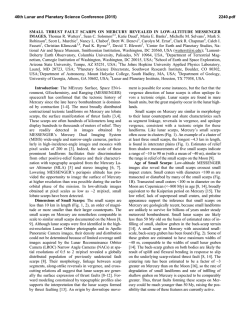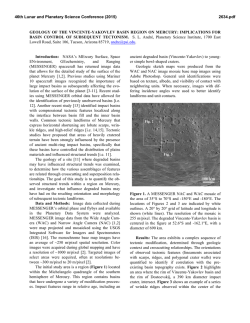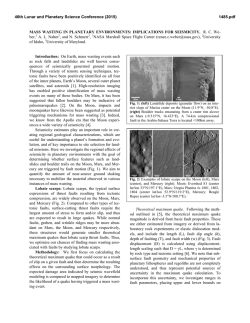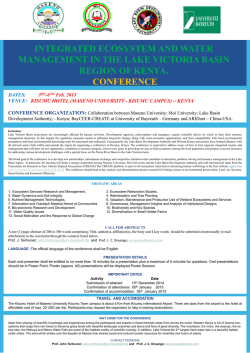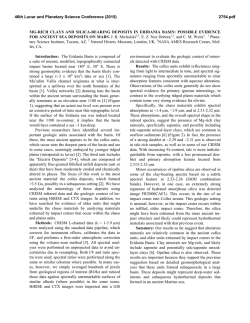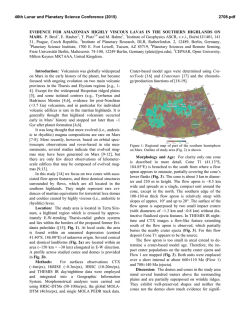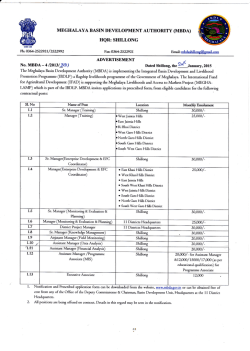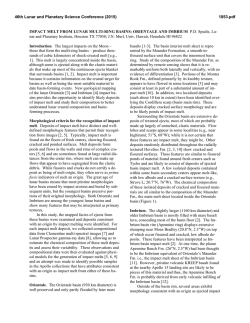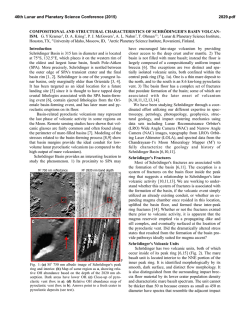
Orientation of Basin-Related Tectonic Features on Mercury
46th Lunar and Planetary Science Conference (2015) 2031.pdf ORIENTATION OF BASIN-RELATED TECTONIC FEATURES ON MERCURY. E. R. Fegan1, D. A. Rothery1, S. J. Conway1, M. Anand1,2 and M. Massironi3, 1Department of Physical Sciences, The Open University, Milton Keynes, MK7 6AA, UK ([email protected]). 2Department of Earth Science, The Natural History Museum, Cromwell Road, London, SW7 5BD, UK. 3Dipartimento di Geoscienze, Università di Padova, Via Giotto 1, 35137 Padova, Italy. Introduction: Lobate scarps on Mercury are curvilinear tectonic features that are interpreted as thrust faults intersecting the surface, formed as the planet contracted. In some places these scarps are found at the edges of flooded impact structures, where compression has resulted in tectonic activation of the boundary between fill and original basin surface as indicated in Fig.1 below. Figure 1: Method of formation for lobate scarps at the edge of volcanically filled basins The lobate scarps formed in this manner appear at first glance to be most common at the east and west borders of basin fill (i.e. with the scarps trending north-south). Orientation of compressive features has been suggested to be of use in interpreting what mechanism was dominant in their formation – possible suggestions are global contraction or despinning, or a combination of the two [1]. In this work, we examine whether the orientation of lobate scarps at the edges of volcanically filled basin is, in fact, preferentially oriented north-south, and draw some preliminary conclusions about the evolution of the planet Mercury. Method: First, we identified basins which have lobate scarps at the edges of their volcanic fill. The survey was based upon the basin database of [2], and conducted by visually examining each basin with diameter > 100 km (using the MESSENGER MDIS global mosaic in ArcMap). By restricting the investigation to features located at the edges of large basins the risk of overlooking some due to illumination bias is reduced, because scarps of this size are apparent upon examination whatever the illumination direction. Following the identification of basins with lobate scarps, we then digitised the lobate scarps. Figure 2: Radial plots for basins 100 km in diameter and above, binned by latitude (north and south binned together) 46th Lunar and Planetary Science Conference (2015) Not all basins have lobate scarps, and the reason for some having them, but not others is not yet clear. Our previous work [3] suggested that basin fills that went on to develop lobate scarps were emplaced within 0.3 Ga of each other, but the relative age of the basins without lobate scarps is not yet known. It is possible that both basin size and composition may also play a role in triggering lobate scarp formation. In order to investigate the former possibility, in this work we divided the basins examined into two categories: 100-199 km diameter and > 200 km diameter. Results: The survey results indicate that lobate scarps are more common in the larger basin category, as shown by our results in Table 1. If the orientation of each scarp segment is plotted on a radial plot binned by latitude (0-30°, 30-60° and 60-90°, N and S plotted together) the results do not indicate a global north-south orientation of basin-related scarps. A north-south orientation is dominant near the equator, but towards both poles east-west orientations become more common (shown in Fig. 2). According to [1], such a pattern would indicate a combined influence of despinning with global compression in forming compressional tectonic features (when the equatorial lithosphere is thin relative to that of the poles). However, if these features formed more recently than the Late Heavy Bombardment, as model ages suggest that they do [3], this is surprisingly late in solar system history for despinning to be occurring. Diameter (km) Total number 100-199 >200 All >100 550 90 640 Number with Lobate Scarps 46 32 78 % with Lobate Scarps 8 36 12 Table 1: Number of basins with lobate scarps in total and by diameter category We suggest the possibility that early despinning imposed a fabric upon the material of the crust, which – when coincidental with a filled basin rim – forms these features upon later compression. This is supported by the fact that in some areas lobate scarps 2031.pdf Figure 3: Anerin basin, rim marked approximately by red circle. Blue arrows indicate lobate scarp at edge of Aneirin fill not limited to that basin, but cutting across Dario basin. related to basin rims are not contained to that basin fill, but extend out beyond it (see Fig. 3). Conclusions: - The particular type of basin tectonisation described above is more likely to affect larger basins (>200 km diameter) than smaller ones. - The orientation of basin-edge scarps varies according to latitude. At high latitudes their orientations are dominantly east-west. At low latitudes their orientations are dominantly north-south. - A variation in orientations with latitude could indicate that a combination of despinning and global contraction were important in the formation of compressive tectonic features on Mercury, and is also possibly indicative of a thinner equatorial than polar lithosphere, as suggested by [1]. References: [1] Beuthe M. (2010) Icarus, 209, 795-817. [2] Fassett C.I. et al (2012) JGR: Planets, 117, doi:10.1029/2012JE004154. [3] Fegan E.R et al (2014) LPSC 45, #1780.
© Copyright 2025
